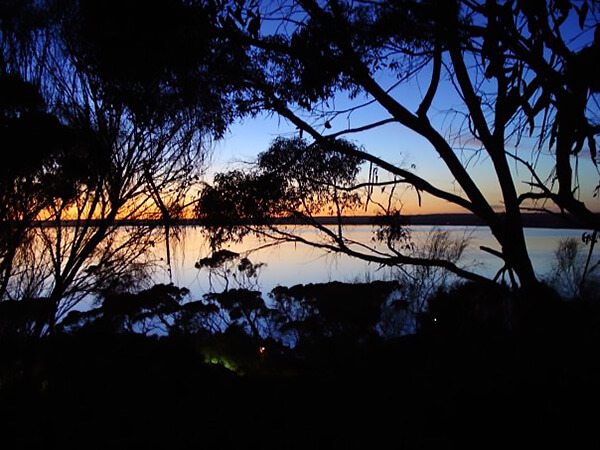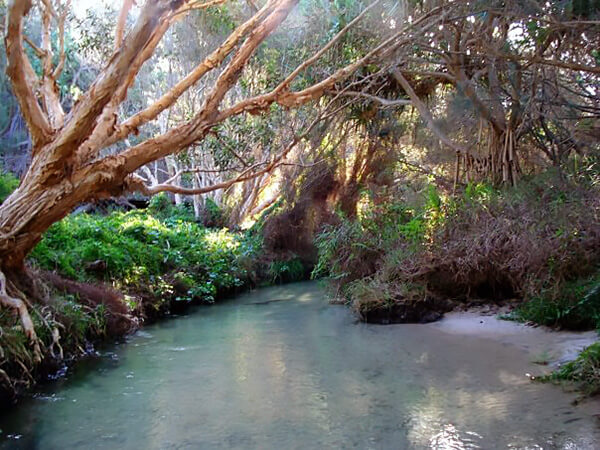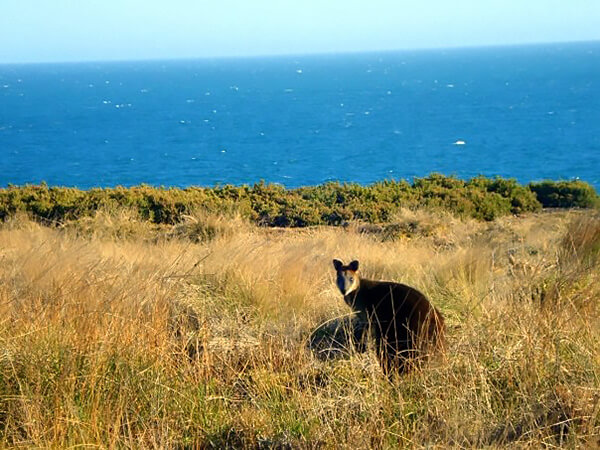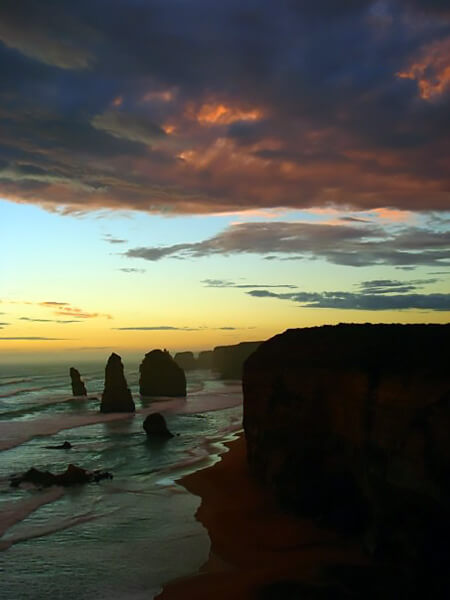Living and Studying Abroad in Australia
Cultural Immersion is the Best Way to Experience the Land Down Under
Article and photos by Carolyn Mueller

|
|
Kangaroo Island at sunrise in Australia.
|
G’day Mates!
The bus made one final stop.
“Here ya are, mates. 39 Colliers Close,” the Australian study abroad representative said.
Welcome to our apartment. I gripped my luggage handle tightly. Here I finally was — the first time I would see the apartment I would share with three roommates. Here was the place I would spend the next six months. It was a little piece of a new city and a launching pad into the entire Australian continent.
The apartment was small but well-furnished. A glass sliding door opened up into a garden. I walked out, surrounded by drooping wildflowers and the shade of three skinny palm trees. The strange whistle of a magpie sounded from the other side of the fence gate. Slowly, I crossed the cobblestone and made my way toward this gate. I wanted to see what was on the other side, what this place looked like, and what Newcastle, Australia, was about.
Pushing open the gate, I vaguely heard the crash of the surf and could smell the slight tang of salt. I walked through the doorway and smiled.
There it was: the ocean.
I threw off my shoes and ran into the sand, wading in past my ankles. The waves roared and crashed, the sun sparkling off each crest with a million flecks of light.
This was Australia.
I fell in love.
Getting to Australia
The road to the little apartment beside the roaring Pacific began early. My sophomore year of college was when I first chose a study abroad destination and program. My first instinct was to go to Europe. Everyone I knew who had studied abroad had gone to Europe. Yet, after many hours in the university’s international study offices, I realized a different dream. I love the outdoors, animals, and adventure. Australia offered an opportunity to explore these interests in a new and unique setting.
Australia’s landmass is larger than Europe's, yet it holds a mere 21 million people. What fills the vast amount of space? Rainforests, beaches, billabongs, glorious coastlines, and miles of empty, rugged desert. It was perfect.
Having chosen Australia as my study abroad destination, I enrolled in a program now run by International Studies Abroad due to my college’s affiliation. The program also provided emergency contact numbers during my time abroad, which was comforting but, fortunately for me, unnecessary. The program was a very solid program, but there are other choices, such as IES, SIT, and CIEE,
are also hosted in Australia.
There are many ways in which Australia is a unique study-abroad destination. For one thing, flying to Australia is an experience in and of itself. On the way there, you will skip an entire day, as even if you leave Los Angeles on a Monday, you will arrive in Sydney on a Wednesday. The experience is disorienting, to be sure, yet it is all part of the journey. Do not let the 15-hour flight intimidate you. Quantas,
the leading airline flying from the U.S. to Australia, is exceptionally friendly, providing reassurance and comfort throughout the flight. The long flight is worth it and makes Australia a perfect study-abroad destination. If you fly to the other side of the world, you might as well stay awhile.
Daily Life and Cost of Living in Australia
During my time abroad, I lived in Newcastle, a city on the eastern coast of Australia, three hours North of Sydney. Newcastle is a surf city with gorgeous beaches, a wonderful harbor, and neighborhoods with true Aussie character. I fell entirely in love with Newcastle. Yet, before going abroad, I knew that I might not have another chance in my lifetime to travel to Australia. Therefore, I made it my goal to leave Newcastle as often as possible. I wanted to see Australia — no small feat when considering the size of this great continent.
I highly recommend taking out a loan before your departure. Someday, you will have the money, but you will invariably have a different amount of time than you do in college. Use this time wisely, see as much as possible, and enjoy being abroad. I borrowed $6,000. Now that the bills from this loan have begun rolling in, I still have no regrets. My experience in Australia was worth every penny.
Aside from basic living expenses, I used most of my loan entirely for travel expenses. In our first week in Newcastle, my roommate and I made a list of goals and budgeted our time and money to meet them. We learned to surf. We saw the famous Opera House, traveled the Great Ocean Road, skydived in New Zealand, and sailed the Whitsundays. Making these priorities early and focusing on certain destinations helped us make the most of our time.
To stretch my loan as far as possible, I tried to eat as cheaply as possible — while still splurging on the occasional box of famous Australian Tim Tam biscuits, of course! Foodworks is a small, convenient grocery store scattered across Australia. It helps pick up an item or two but is quite expensive. I would recommend trying to find the big convenience marts in your city. Doing so might require a bus ride or some exploration, but it is worth it in order to save on groceries. IGA and Coles are two larger stores with reasonable prices, and Big W often offers prices that fit a student’s budget.
Dining out is pricy. An Australian restaurant entrée will set you back between 20-30 Australian dollars and a 3-course meal for 2 can run you 80 dollars on average, often too much for anything more than the occasional celebratory splurge. Yet most cities have cheaper “fish n’ chip” shops where one can pick up a quick bite with authentic Aussie flavor. While on the road and staying in a hostel, the frugal student can “adopt” leftover food from previous travelers. Most Australian hostels have an area in the kitchen for departing guests to leave any unopened and unwanted food. I often found an unopened can of soup or a package of biscuits through this form of “pass it on” food network method.
Basic living expenses such as toiletries and make-up are also quite expensive in Australia. I recommend taking these items from home. The only toiletry I suggest buying in Australia is sunscreen. I found that the sunscreen manufactured in Australia was much more robust and lasted much longer than the American brands I brought from home. Whether on the beach, in the desert, or simply traveling, sunscreen in Australia is a must.
Daily travel in Australia can also add up. I found the most convenient form of travel to be via Australian train system.I took the train to school each morning, out at night, and often to Sydney for the weekend. The trains are clean and fast and pass through lovely eucalypt landscapes. You can also meet interesting people on the trains, as it is a typical form of travel for many locals, particularly students of any age. Train prices vary. For me, a trip to school (about six stops) costs around three Australian dollars. The three-hour ride to Sydney was 20. You can purchase student discount tickets from the station machines, but be warned — just because you are technically a “student” (even a temporary student at an Australian university) does not mean you qualify for the student train rates. Most people I know tended to ignore this fact and purchased student-priced tickets anyway, at the risk of being potentially fined. If you can get away with it, it can save you a lot of money in the long run.
Buses are also a great form of transportation. I often utilize the bus system for grocery shopping or running general errands. The bus system is slower than the trains, as is often the case. Check the rates first and ensure you are familiar with the timetable before planning a trip.
Volunteer Work in Australia
If you are hoping to work or volunteer in Australia it is fairly easy to get a job with a working holiday visa directly, or through agencies such as BUNAC, who handle much of the paperwork and help with the transition for a fee.
For example, a typical serving job in Australia might pay 20 Australian dollars an hour. The wage is because gratuity is usually included in menu pricing, so unlike in the U.S., waiters or waitresses do not make the majority of their income from tips. Yet a few friends of mine served fish n’ chips a couple of nights a week and were able to pick up a substantial amount of travel money as a result.
I chose to volunteer abroad with Conservation Volunteers Australia. I spent my time eradicating invasive plant species brought by Europeans to the continent in the nineteenth century. It was hard work but a fun way to learn about the native environment, meet new people, and experience a unique place while doing something to give back to the land I had come to love.

|
|
Ely River as it flows through an Australian forest.
|
Studying Abroad in Australia
Much of my education in Australia derived from life experiences. I learned more about exploring new landscapes, getting lost in foreign city streets, and chatting with locals and fellow travelers than I did in the classroom. Yet, university requirements are typically an essential and mandatory part of the experience for most study-abroad students.
I attended the University of Newcastle in New South Wales. Like most Australian universities, the University of Newcastle is in “the bush,” i.e., land that did not interest real estate developers. Though this made for a bit of a trek, the university is blessedly near a gorgeous natural landscape. On my walk from the train station to class, I often encountered the screeching of cockatiels, a rainbow flash of lorikeets, or, if I was fortunate, the hilarious jungle-like cackling of a kookaburra. Despite the beauty of the campus, one of the best decisions I made abroad was to live off-campus.
American students often live on campus to immerse themselves in the study abroad experience. However, living in Newcastle gave me a fuller immersion into Aussie culture. Most Americans I knew who lived at the university tended to hang out with other Americans. Yet I believe that part of the personal growth and journey of living abroad is to leave one’s natural comfort zone behind. Living off campus, I could make friends with my neighbors, including the Aussies renting apartments around us, and quickly became friends. They taught my roommates and me to play cricket, host an authentic Aussie barbeque, and spearfish in the sea. We surfed, traveled, and spent many nights swapping stories over a box of wine with these locals. I would not have had these same opportunities if I had chosen to live at the university.
When choosing my classes, however, I sincerely aimed to learn about Australian history and culture. So, I enrolled in the Australian History, Australian Literature, and Aboriginal Studies course. Yet, in which class did I learn the most about the Australian people? Ceramics.
I certainly had good intentions in my quest to learn about my temporary home through university classes. Yet every other American in Newcastle had the same intentions. I found that I shared my Australian classes with more Americans than Australians. I did not get to hear typical Australian views on Aboriginal culture. I did not get to chat with my classmates about the history of their native country. I did, however, get to do these very activities in ceramics class. Choosing the ceramics class was a spur-of-the-moment decision that left me sharing a kiln with half a dozen Australian women, most over 50. We spent many happy afternoons up to our elbows in clay, talking politics and culture and comparing how we each said the word “ocean.”
Of course, I learned many valuable facts about Australian history during my semester studies. However, I could have learned much from reading a history book during the long flight. If you seek immersion into local culture abroad, I recommend avoiding classes with “Australian” in the title. These are sure to attract more Americans than the more typical university courses.
Night Life in Australia
Do explore Australian nightlife, if you are so inclined. The pub scene is an integral part of Australian culture. From dancing to techno beats to having a beer with the blokes while watching footy, Australians of all ages converge to enjoy the night scene. It is important to note that “hotel” in Australia means the same as “pub.” So, if you see a sign advertising “hotel,” it is likely not a place to sleep but rather, more likely, a bar.
Like food and toiletries, alcohol is quite expensive in Australia. For example, a typical bottle of vodka, which might cost fifteen U.S. dollars, will cost around forty Australian dollars. A beer is complex to come by for less than six. And please note, “Foster’s” is certainly not “Australian for Beer,” as their slogan says. Most Australians frequently drink Toohey’s or Victoria Bitter instead.
I mistakenly assumed that Australia’s famous, laid-back beach culture translated to laid-back party attire. I packed almost nothing in terms of footwear but flip-flops (or, as the Aussies say, thongs). Most bars will not allow you to enter with open-toed footwear. It is common for Australians to finish a drink and then drop their glass on the ground, meaning that most bars are littered with shards of broken glass, making heels or some more formal footwear necessary.
Sample some typical Aussie nighttime fare when returning home after a night out. Stands catering to late-night partyiers feature food items such as minced meat and pea-stuffed shepherd’s pie. Some church groups will even set up BBQ stands with free food. But beware — a typical “Aussie Barbie” does not mean shrimp, nor does it include American hamburgers. An Australian barbeque is generally long sausages wrapped in white bread and topped with onions.
Travel within Australia
If you have made it to the great Australian continent, you should see as much of it as possible. Fortunately, this is a feasible dream for even the most frugal student traveler. The one thing cheaper in Australia compared to the U.S. is airfare. Aside from train trips to Sydney and the Blue Mountains, I flew almost everywhere. Cheap airlines such as JetStar, and Virgin Australia provide safe and affordable flights minus the luxuries of Qantas, but they are perfect for the student traveler.
If you have made it to the great Australian continent, you should see as much of it as possible. Fortunately, this is a feasible dream for even the most frugal student traveler. The one thing cheaper in Australia compared to the U.S. is airfare. Aside from train trips to Sydney and the Blue Mountains, I flew almost everywhere.
Once you have arrived at your destination, finding a place to stay is relatively easy. Australia is famous for its safe, clean network of hostels. The most well-known is the Australian Youth Hostel Association (YHA). You can find at least one YHA hostel in most every major city, township, or tourist destination in Australia. These backpacker havens are relatively cheap (around US$15-30 a night), fun (Melbourne’s features a rooftop lounge, Sydney’s a game room, a bistro, and Sunshine Coast’s a pool with lazy hammocks and kayaks), and legally bound to abide by clean standards. YHA memberships will provide you with a discount at most destinations. Other hostels are easy to locate in most locations and are great places to meet fellow travelers. I often slept in 10-bedroom dorm rooms with other men and women from all over the world. I could go out with these backpackers and share food or wine, stories, or travel tips. Hostels also arrange interesting tours at discount rates. I could see the Great Ocean Road through hostels and tour New South Wales’ wineries. Even if you are not staying at a hostel, inquire about activities sponsored by the hostel in your local town. It is a great way to meet people and see some memorable sites.

|
|
A wallaby.
|
Ready, Set, Go!
Australia is a part of the world where swans are black, and pine trees grow with their needles pointing backward. Winter is in July, and summer is in January. In the north, it is warm, and in the south, it gets colder. Peppers, raisins, and shrimp are capsicums, sultanas, and prawns. Mammals lay eggs, penguins burrow in sand, and foxes fly. It is a place of contrast and absurdity. I will remember it and love it forever.
My best advice is to go and do not look back. You will make mistakes, learn about yourself, and explore a wonderful part of the world. Throw yourself into all that rolling sunshine and let the adventure happen.

|
|
Twelve Apostles at sunset.
|
Carolyn Mueller has a BA in Creative Writing from DePauw University.
|
